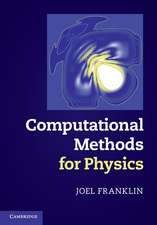Polygons, Polyominoes and Polycubes: Lecture Notes in Physics, cartea 775
Editat de A. J. Guttmannen Limba Engleză Hardback – 18 mai 2009
| Toate formatele și edițiile | Preț | Express |
|---|---|---|
| Paperback (1) | 400.47 lei 6-8 săpt. | |
| SPRINGER NETHERLANDS – 23 aug 2016 | 400.47 lei 6-8 săpt. | |
| Hardback (1) | 410.88 lei 6-8 săpt. | |
| SPRINGER NETHERLANDS – 18 mai 2009 | 410.88 lei 6-8 săpt. |
Din seria Lecture Notes in Physics
- 19%
 Preț: 424.00 lei
Preț: 424.00 lei - 17%
 Preț: 360.73 lei
Preț: 360.73 lei -
 Preț: 429.22 lei
Preț: 429.22 lei - 17%
 Preț: 427.62 lei
Preț: 427.62 lei - 17%
 Preț: 460.26 lei
Preț: 460.26 lei -
 Preț: 427.96 lei
Preț: 427.96 lei -
 Preț: 481.93 lei
Preț: 481.93 lei - 17%
 Preț: 494.66 lei
Preț: 494.66 lei -
 Preț: 281.90 lei
Preț: 281.90 lei - 17%
 Preț: 493.20 lei
Preț: 493.20 lei - 17%
 Preț: 426.72 lei
Preț: 426.72 lei -
 Preț: 365.15 lei
Preț: 365.15 lei -
 Preț: 374.52 lei
Preț: 374.52 lei -
 Preț: 407.98 lei
Preț: 407.98 lei - 20%
 Preț: 428.13 lei
Preț: 428.13 lei -
 Preț: 263.30 lei
Preț: 263.30 lei - 15%
 Preț: 593.73 lei
Preț: 593.73 lei - 15%
 Preț: 528.13 lei
Preț: 528.13 lei -
 Preț: 493.12 lei
Preț: 493.12 lei - 17%
 Preț: 425.68 lei
Preț: 425.68 lei -
 Preț: 280.65 lei
Preț: 280.65 lei -
 Preț: 163.41 lei
Preț: 163.41 lei - 18%
 Preț: 726.59 lei
Preț: 726.59 lei -
 Preț: 394.84 lei
Preț: 394.84 lei - 15%
 Preț: 709.63 lei
Preț: 709.63 lei - 15%
 Preț: 623.90 lei
Preț: 623.90 lei - 20%
 Preț: 476.93 lei
Preț: 476.93 lei - 15%
 Preț: 428.05 lei
Preț: 428.05 lei -
 Preț: 342.78 lei
Preț: 342.78 lei - 18%
 Preț: 851.93 lei
Preț: 851.93 lei -
 Preț: 346.61 lei
Preț: 346.61 lei -
 Preț: 391.57 lei
Preț: 391.57 lei - 15%
 Preț: 633.16 lei
Preț: 633.16 lei -
 Preț: 451.71 lei
Preț: 451.71 lei - 5%
 Preț: 1497.80 lei
Preț: 1497.80 lei -
 Preț: 374.85 lei
Preț: 374.85 lei -
 Preț: 380.07 lei
Preț: 380.07 lei - 15%
 Preț: 516.14 lei
Preț: 516.14 lei - 15%
 Preț: 583.78 lei
Preț: 583.78 lei - 15%
 Preț: 508.60 lei
Preț: 508.60 lei -
 Preț: 469.73 lei
Preț: 469.73 lei -
 Preț: 388.90 lei
Preț: 388.90 lei - 15%
 Preț: 500.24 lei
Preț: 500.24 lei -
 Preț: 386.52 lei
Preț: 386.52 lei - 15%
 Preț: 472.88 lei
Preț: 472.88 lei -
 Preț: 424.27 lei
Preț: 424.27 lei -
 Preț: 380.07 lei
Preț: 380.07 lei - 15%
 Preț: 500.01 lei
Preț: 500.01 lei
Preț: 410.88 lei
Nou
Puncte Express: 616
Preț estimativ în valută:
78.62€ • 84.07$ • 65.55£
78.62€ • 84.07$ • 65.55£
Carte tipărită la comandă
Livrare economică 17 aprilie-01 mai
Preluare comenzi: 021 569.72.76
Specificații
ISBN-13: 9781402099267
ISBN-10: 1402099266
Pagini: 490
Ilustrații: XIX, 490 p.
Dimensiuni: 155 x 235 x 25 mm
Greutate: 0.95 kg
Ediția:2009
Editura: SPRINGER NETHERLANDS
Colecția Springer
Seria Lecture Notes in Physics
Locul publicării:Dordrecht, Netherlands
ISBN-10: 1402099266
Pagini: 490
Ilustrații: XIX, 490 p.
Dimensiuni: 155 x 235 x 25 mm
Greutate: 0.95 kg
Ediția:2009
Editura: SPRINGER NETHERLANDS
Colecția Springer
Seria Lecture Notes in Physics
Locul publicării:Dordrecht, Netherlands
Public țintă
ResearchCuprins
History and Introduction to Polygon Models and Polyominoes.- Lattice Polygons and Related Objects.- Exactly Solved Models.- Why Are So Many Problems Unsolved?.- The Anisotropic Generating Function of Self-Avoiding Polygons is not D-Finite.- Polygons and the Lace Expansion.- Exact Enumerations.- Series Analysis.- Monte Carlo Methods for Lattice Polygons.- Effect of Confinement: Polygons in Strips, Slabs and Rectangles.- Limit Distributions and Scaling Functions.- Interacting Lattice Polygons.- Fully Packed Loop Models on Finite Geometries.- Conformal Field Theory Applied to Loop Models.- Stochastic Lowner Evolution and the Scaling Limit of Critical Models.- Appendix: Series Data and Growth Constant, Amplitude and Exponent Estimates.
Textul de pe ultima copertă
This unique book gives a comprehensive account of new mathematical tools used to solve polygon problems.
In the 20th and 21st centuries, many problems in mathematics, theoretical physics and theoretical chemistry – and more recently in molecular biology and bio-informatics – can be expressed as counting problems, in which specified graphs, or shapes, are counted.
One very special class of shapes is that of polygons. These are closed, connected paths in space. We usually sketch them in two-dimensions, but they can exist in any dimension. The typical questions asked include "how many are there of a given perimeter?", "how big is the average polygon of given perimeter?", and corresponding questions about the area or volume enclosed. That is to say "how many enclosing a given area?" and "how large is an average polygon of given area?" Simple though these questions are to pose, they are extraordinarily difficult to answer. They are important questions because of the application of polygon, and the related problems of polyomino and polycube counting, to phenomena occurring in the natural world, and also because the study of these problems has been responsible for the development of powerful new techniques in mathematics and mathematical physics, as well as in computer science. These new techniques then find application more broadly.
The book brings together chapters from many of the major contributors in the field. An introductory chapter giving the history of the problem is followed by fourteen further chapters describing particular aspects of the problem, and applications to biology, to surface phenomena and to computer enumeration methods.
In the 20th and 21st centuries, many problems in mathematics, theoretical physics and theoretical chemistry – and more recently in molecular biology and bio-informatics – can be expressed as counting problems, in which specified graphs, or shapes, are counted.
One very special class of shapes is that of polygons. These are closed, connected paths in space. We usually sketch them in two-dimensions, but they can exist in any dimension. The typical questions asked include "how many are there of a given perimeter?", "how big is the average polygon of given perimeter?", and corresponding questions about the area or volume enclosed. That is to say "how many enclosing a given area?" and "how large is an average polygon of given area?" Simple though these questions are to pose, they are extraordinarily difficult to answer. They are important questions because of the application of polygon, and the related problems of polyomino and polycube counting, to phenomena occurring in the natural world, and also because the study of these problems has been responsible for the development of powerful new techniques in mathematics and mathematical physics, as well as in computer science. These new techniques then find application more broadly.
The book brings together chapters from many of the major contributors in the field. An introductory chapter giving the history of the problem is followed by fourteen further chapters describing particular aspects of the problem, and applications to biology, to surface phenomena and to computer enumeration methods.
Caracteristici
The only book devoted to polygons Presents a class of ultra-fast counting algorithms New experimental mathematics techniques to conjecture exact solutions Powerful mathematical tools to solve polygon problems













